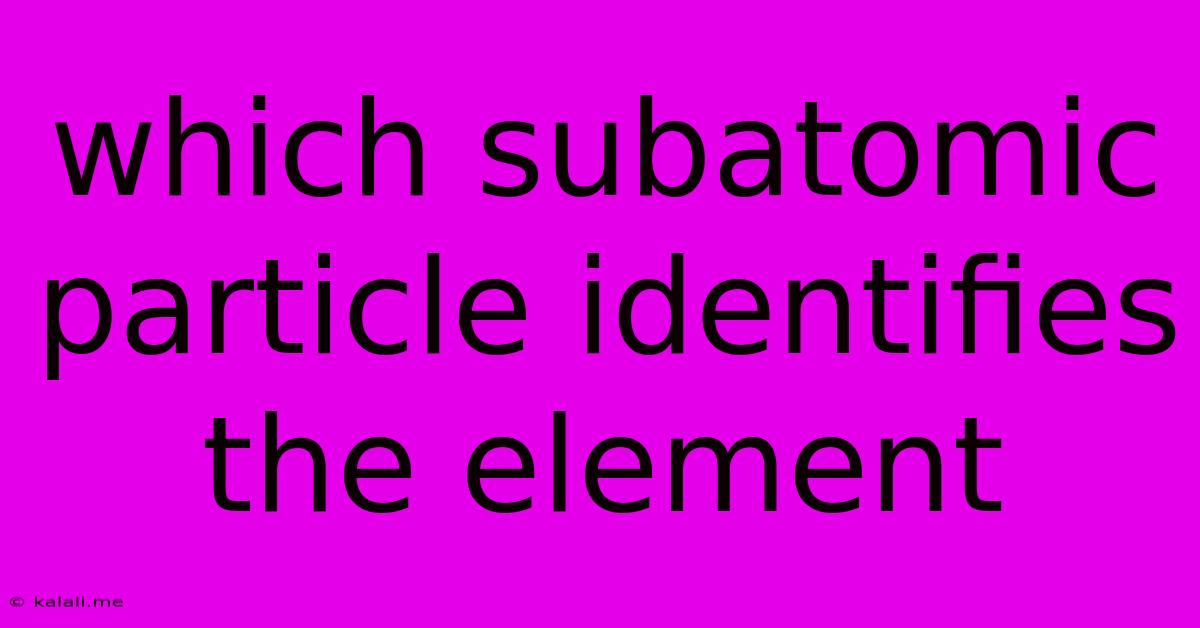Which Subatomic Particle Identifies The Element
Kalali
May 09, 2025 · 3 min read

Table of Contents
Which Subatomic Particle Identifies the Element? The Proton's Crucial Role
Understanding the building blocks of matter is fundamental to chemistry and physics. Atoms, the basic units of elements, are composed of subatomic particles: protons, neutrons, and electrons. But which of these tiny particles truly determines the identity of an element? The answer, quite simply, is the proton. This article will delve into why the proton holds this crucial role and explore the related concepts of atomic number and isotopes.
This article explains the fundamental role of protons in identifying elements, differentiates them from neutrons and electrons, and discusses how the number of protons defines an element's properties. It also touches upon the concept of isotopes and how they relate to the overall identity of an element.
The Proton: The Defining Characteristic of an Element
The number of protons in an atom's nucleus is its atomic number. This number uniquely identifies an element. Each element on the periodic table has a distinct atomic number. For example, hydrogen (H) has an atomic number of 1 (one proton), helium (He) has an atomic number of 2 (two protons), and so on. This means that if you change the number of protons, you fundamentally change the element itself. Adding or subtracting a proton transforms the atom into a completely different element with vastly different chemical and physical properties.
Neutrons and Electrons: Important, but Not Defining
While neutrons and electrons are vital components of an atom, they don't define the element in the same way protons do.
-
Neutrons: These particles reside in the nucleus alongside protons and contribute to an atom's mass. However, changing the number of neutrons in an atom creates an isotope, a variation of the same element. Isotopes of an element have the same number of protons but differ in the number of neutrons. For example, carbon-12 and carbon-14 are both isotopes of carbon; they both have 6 protons, but carbon-12 has 6 neutrons, while carbon-14 has 8 neutrons. Despite the difference in neutrons, they remain carbon.
-
Electrons: These negatively charged particles orbit the nucleus and are responsible for chemical bonding and reactivity. The number of electrons can vary within an atom (forming ions), but this doesn't change the element's identity. For instance, a sodium atom (Na) can lose an electron to become a sodium ion (Na+), but it remains sodium.
Atomic Number: The Key to Elemental Identity
The fundamental concept linking protons to elemental identity is the atomic number. This single number, representing the number of protons, is the definitive characteristic that distinguishes one element from another. It dictates the element's position on the periodic table and largely determines its chemical behavior. The periodic table itself is organized based on increasing atomic number, reflecting the fundamental role of protons in defining the elements.
Understanding Isotopes and Elemental Identity
It's crucial to understand the distinction between isotopes and the element itself. While isotopes have varying numbers of neutrons, they retain the same atomic number (number of protons), and thus, remain the same element. Their different neutron counts affect their mass and sometimes their radioactivity, but not their fundamental chemical properties. For example, both carbon-12 and carbon-14 exhibit similar chemical behavior because they both have six protons.
In summary, the proton is the subatomic particle that uniquely identifies an element. The number of protons, or the atomic number, is the defining characteristic that determines an element's position on the periodic table and its chemical properties. While neutrons and electrons play significant roles in atomic structure and behavior, they do not determine the elemental identity.
Latest Posts
Latest Posts
-
How Many Cups Is 1 Pound Of Cheese
Jul 12, 2025
-
30 X 30 Is How Many Square Feet
Jul 12, 2025
-
How Much Does A Half Oz Weigh
Jul 12, 2025
-
Calories In An Omelette With 3 Eggs
Jul 12, 2025
-
How Do You Say Great Grandmother In Spanish
Jul 12, 2025
Related Post
Thank you for visiting our website which covers about Which Subatomic Particle Identifies The Element . We hope the information provided has been useful to you. Feel free to contact us if you have any questions or need further assistance. See you next time and don't miss to bookmark.